IWD – 2020s Vision: Dr. Shane Gould On Swimming Culture After A Lifetime Of Learning
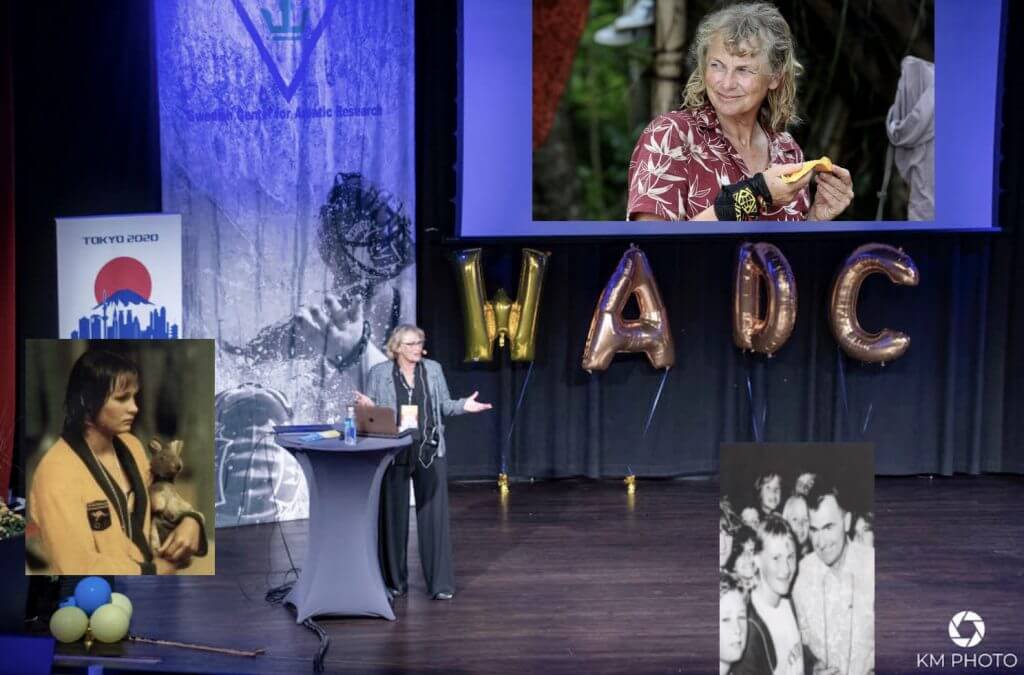
2020s Vision – Swimming Culture – Sunday Essay
International Women’s Day (IWD)
To mark International Women’s Day, Swimming World is rolling out a series of features this Sunday, fresh and from the archive, to highlight the achievements and work of pathfinders in swimming and raising issues that continue to have a massive impact on women in sport.
Here we consider a lifetime of learning and where it’s brought the legendary Shane Gould too, including advocacy for abuse victims that joins her voice to that of Nancy Hogshead-Makar and others fighting for safe sport and redress for victims.
Originally published on Australia Day – January 26, 2020:
The name’s Shane Gould. Dr. Shane Gould.
At 15, she raced to what remains the single biggest solo-swims medal haul at one Olympic Games, three of five orbs the colour gold. Pour a rip tide under that bridge and look up. At 61, she became the oldest winner ever among more than 60 countries over two decades of the reality-TV show Survivor. Within the year, she would be awarded a Doctor of Philosophy (PhD) from Victoria University after several years of study and a lifetime of experience.
Her topic: The Culture of Swimming in Australia.
I met up with Gould in Lund this month at the forward-looking World Aquatic Development Conference (WADC) that chose the focus of the work of one of Australia’s official National Living Treasures: Swimming Culture. That in turn inspired the second theme in our quarterly 2020s Vision series: Swimming Culture – what is it? Our introductory piece will be followed bye others own the theme in February.
We dedicate our efforts to Gould this Australia Day by looking at the subject, questions and findings of her thesis and her first presentation on the theme in Lund.
Gould’s somewhat mis-told journey is stacked with libraries of learning. The who she was, who she became and who she is was never more obvious to the Australian public than when they tuned in to the way she played Survivor back in 2018.
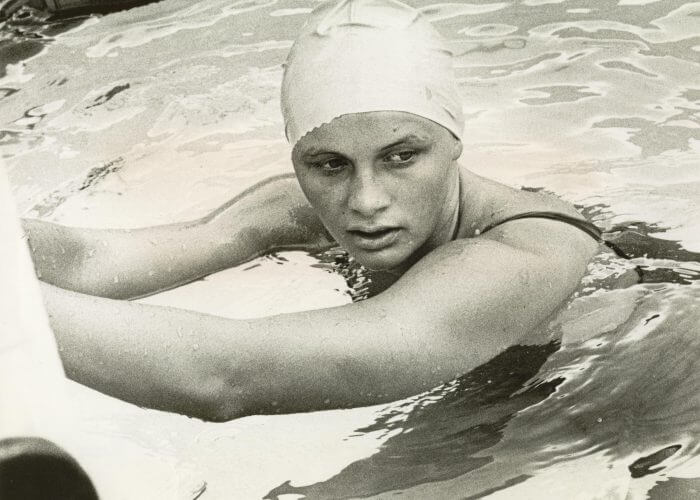
Shane Gould – Photo Courtesy: Kevin Berry/Swimming World Archive
Setter of 11 World Records and winner of three golds (all in world records), a silver and a bronze at Munich 1972, in a shooting-star swim career that glows brightly yet in the realm of Olympic achievements, Gould played to her strengths. In a conversation for another time, she tells me that when when she signed up for Survivor, she did her homework.
She made sure she could cover all the basics, like lighting a fire with a flint; working out the kind of games she would be good at, the kind she would not. While some felt a need to win at every turn, Gould identified the things she was not the best at, did what was required not to fail but wasted no more energy than necessary in pursuit of what could not be won.
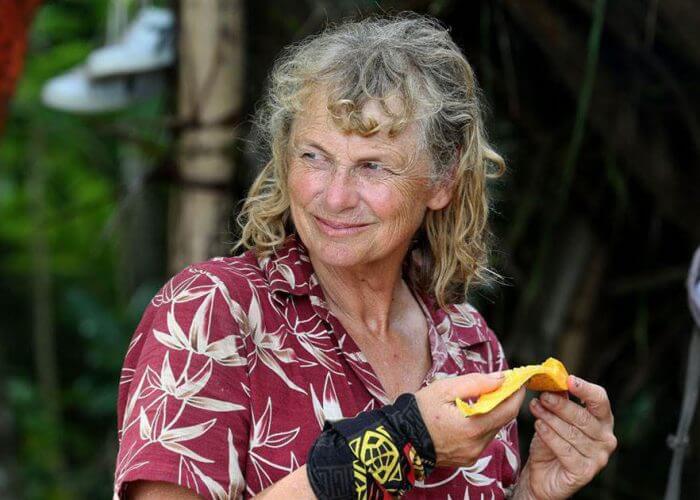
Shane Gould, the strategist worked out how to survive and become the oldest winner of Survivor anywhere in the world – Photo Courtesy: Survivor, Channel 10, Shane Gould
That led her to what could be won: yes, Aus$500,000 is always helpful but not as much as what she likes to do best – learn.
Gould’s a survivor well beyond Survivor. A part of why is this answer to how she would sum up her quest to quench her thirst for knowledge:
“I like to ask questions about how to make the world a better place. I directed my attention to the movement culture of swimming in 4 different academic studies since 2007. I used storytelling through film, photographs and words.”
Since 2007:
- Diploma of Documentary Film, Sydney Film School 2007, “Blokes in Cossies” film project.
- Masters of Environmental Management UTAS 2010 (Swimming pools as a public space)
- Masters of Contemporary Art UTAS Academy of Arts looking at swimming images in contemporary art.
- The culmination was a doctor of philosophy at Victoria University Melbourne
Swimming in Australia: A cultural study
Gould graduated in a Victoria University ceremony on December 11, 2019, a couple of weeks beyond her 63rd birthday. This is the citation for her PhD that describes her 90,000 word thesis:
“Shane developed a multi-dimensional framework that enabled her to investigate the political, economic and social forces that shape swimming practices and experiences in Australia. Her thesis reveals various forms of exclusion that are embedded within the unquestioned logic of swimming culture. Shane’s research makes a significant contribution to the swimming industry by providing innovative solutions to make swimming more inclusive.”
Gould says: “I chose Victoria University because “they had the faculty that taught about sport and recreational culture, not just science of sport performance or recreational participation. I also chose Victoria University because of the two academics who supervised my research project, Dr Brent McDonald and Dr Fiona McLachlan.”
The university saw the value in her research proposal and granted Gould a scholarship to study, not just the subject but how to tackle it, a study of studying the first step to getting to where she wanted to get to. She explains:
“In the first year, I travelled to Melbourne each week from Tasmania where I live, for foundational courses, such as ethics in research, research methodology and academic frameworks of thinking. These foundational subjects were instrumental in ensuring I successfully completed the next 4 years, some of which was part-time. In subsequent years I was able to study from home and check in every two weeks with my supervisors. I attended two, week-long writing workshops too and some in house lectures. I was able to access academic journals online through the library or purchase books online. So it is possible to study remotely according to my subject and the flexibility of the staff.”
Some key findings of Gould’s research:
- Swimming is indeed popular in Australia, but not in the way representations of swimming are depicted. There is more wading and bathing than horizontal swimming as a result horizontal swimming skills are generally poor.
- Swimming pools are designed for horizontal swimming, not for more common types of swimming done in pools and in the ocean. More 25 metre pools with shallow areas and some deep water should be built, not expensive 50 metre limited-use aquatic centres.
- Statistics and participation data are inadequate because of poor non-specific questions asked in surveys and census. For example recreational swimming is not distinguished from sport swimming.
- Swimming is used as a national identity narrative. ‘Australians are swimmers’ even though a majority of people are not good swimmers.
- Elite swimmers who represent Australia are sought after as diplomatic envoys. However, they are not trained to be diplomats in meet and greets with politicians, with international business agents or embassy officials. Increasingly nation states are using sport for diplomacy. Australian national team swimmers though are unskilled representatives. They need to be up-skilled and educated for the unintended/unexpected roles they play in world understanding and peace.
- Parents need to give more context to childrens’ swimming learning experiences by going to water to play after completing a series of lessons not just go to lessons which for many children come to believe swimming equals just constrained organised learning. Parents often need the lessons so they can model their behaviours to their children when they go to water as a family outing.
- There are hundreds of swimming pools in Australia that are not being used as much as they could be. If they were conceived as a public meeting place, or as an adventure playground, then there would be more creative play at pools and improved water safety and swimming skills developed.
- Swimming clubs are great community organisations where children and adults can improve skills and fitness, race and socialise. However, competition youth sport loses too many children by modelling adult sport with the demand to swim more than 4 times a week in training. A corollary to this is that swimming coaches need to be valued as youth workers, not just professionally advancing by producing high performance athletes in late adolescence.
- Adult ocean swimming is very popular, as a way to engage with nature, maintain health like bushwalking and beach walking and doing fun runs. There seems to be an identifiable loose swimming group of robust Aussies in most swimmable towns, upholding the slogan Australians are a nation of swimmers.
But are they? Is the notion that swimming is in the Australian DNA true? These and many other questions were posed by Gould in the course of researching for her doctorate.
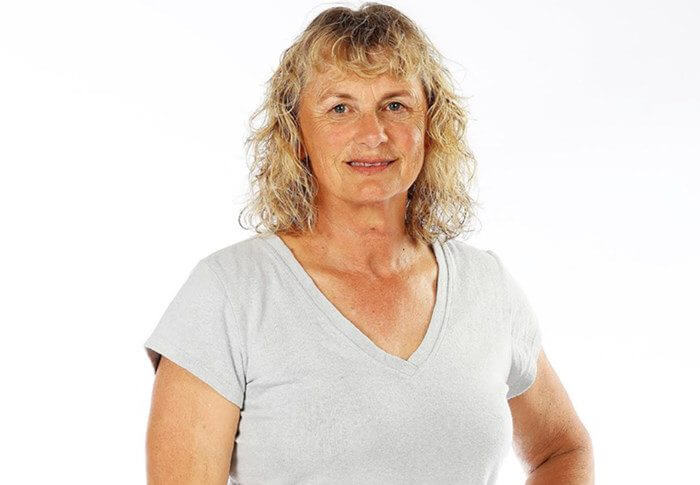
Shane Gould – Photo Courtesy: Survivor, Channel 10, Shane Gould
She asked: Swimming is not just an activity or a business, it is also a type of movement culture. What are common cultural features of swimming that all swimming disciplines share? Perhaps values, meanings, language and rituals – and what are those?
While she retired from competitive swimming in the 1970s, her interest in swimming remained strong. Her will to reconnect with the water rose to new heights in the 1990s – and in 1998 she was declared one of Australia’s 100 Living National Treasures, after the honour was created the year before.
In her pursuit of understanding led her to a man she would marry, Milt Nelms, the American coach known as “the Water Whisperer” for his Nelmsing Method that seeks to get the swimmer to understand their place inside and relationship with the element they’re immersed in and aim to have help them produce propulsive speed.
Nelms co-founded the Swedish Centre for Aquatic Research (SCAR) with SK Poseidon coach Thorbjörn Holmberg and his wife Hilde Elise Hansen, organiser of the WADC in Lund.
Swimming World was present when Gould presented insights from her PhD thesis in Lund this month and asked participants to take part in an active thinking session about aspects of swimming culture that all swimming practitioners share – more ‘red threads’ that unite people and define the culture.
Dr. Shane Gould In Her Own Words
An Extract From One Of Three Presentations At The WADC
Swimming as Culture
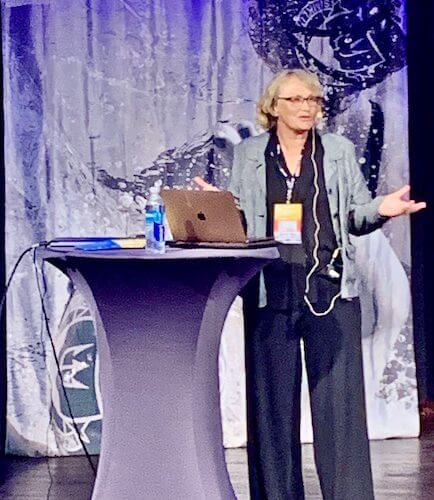
Shane Gould in Lund – Photo Courtesy: Craig Lord
Between 2014 and 2019 I did a doctor of philosophy, studying the culture of swimming in Australia. I graduated in December 2019. A philosophical study involves asking questions about meanings and values.
From a young age I have persistently asked questions, how, why, where, when, what for, what does that mean? So it was a logical progression in my late 50’s to submit to the rigours of postgraduate study and ask philosophical questions about swimming.
When I did a literature review I also read organisational reports, surveys, systematic reviews and press releases circulated by Swimming Australia, Royal Life Saving Society and other swimming focussed organisations.
I recognised a pattern in the introductions of these documents. A phrase that was consistently used ‘ Swimming is a popular activity’.
I asked how do they know that swimming is popular? Is it true? What do they mean by popular? This led to me interpreting statistical data, revealing poor survey questions and hollow conclusions about the popularity of swimming. I also observed that there was a lot of vertical swimming, rather wading, not swimming. So I asked do people swim when they go swimming. So what is swimming?
Ah, it’s fun to philosophise!
My research investigation also unearthed the slogan Australia is a Nation of Swimmers. From about 2015 another slogan began appearing more often, Swimming is in Australia’s cultural DNA
Again I asked, what is meant by cultural DNA?
What I discerned is that Australians have a belief that they are swimmers. Australians are swimmers is a narrative about national identity. It is a made up story that provides a sense of belonging with like-minded people. ‘Sweden is a just and fair society,’ for example.
As I dived into getting answers to my questions, I realised that the use of culture in relation to swimming was more about organisational culture, borrowed from business. Culture was the hottest topic in 2015.
Apparently Culture was the Merriam-Webster’s dictionary word of the year in 2014 because the word culture showed the biggest spike of ‘look-ups’ on their website that year.
What I concluded after examining the landscape of swimming practises in Australia is that swimming is not just an activity or a business, it is also a type of culture.
What I mean by culture is that it is a way of life, influenced by the meanings and values people share. It is not the sort of definition of culture that business has appropriated. I want to be sure to distinguish between organisational culture and swimming culture as a human way of life.
In this presentation I intend to identify some common cultural features of swimming that all swimming disciplines share. Those disciplines are represented here at this conference by you in teachers of learn to swim, swimming therapy, age group swimming, coaching elite competition swimming and recreational fitness swimming.
Firstly though I will define what I mean by culture in relation to swimming as this definition provides us with the questions I am posing to us all ‘what is the swimming culture I am involved with?’
A dictionary definition states Culture is a word for the ‘way of life’ of groups of people, meaning the way they do things. … Excellence of taste in the fine arts and humanities, also known as high culture. An integrated pattern of human knowledge, belief, and behaviour. The outlook, attitudes, values, morals, goals, and customs shared by a society.
Dictionary definitions are often 2 dimensional, and don’t reflect evolving uses of the word generated in popular life. I think that is the case with the dictionary definition of culture. But I do like the aspect of the description of culture ‘as a way of life, the way people do things’.
There is an excellent 2014 article in the New Yorker magazine discussing the meaning of culture. The author Joshua Rothman says that culture is a confusing word because it is more than the sum of its definitions. So culture covers a lot of definitions and is appropriate in relation to swimming. Consider clothing for swimming such as jammers, burkini, or other words with specific meanings such as streamline, kick, googles, flip turn.
Culture is a good word to use for us involved with all aspects of swimming. The business of swim schools, the youth work of age group swimming, the drowning prevention, the therapy, the sport, the science of performance, the production and sale of pools and equipment. There is a pattern of threads through all of those aspects of the swimming industry which act as a connectors for swimming culture – a shared way of life, shared meaning and values.
To help you even more to get into the way of thinking about swimming as culture, I’ll share some of my behaviours, meanings and values for swimming with you.
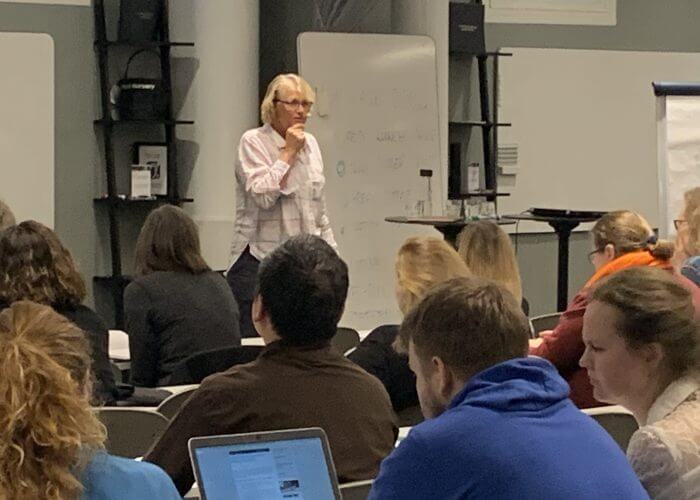
Shane Gould teaches the teachers in Lund – Photo Courtesy: Craig Lord
Swimming is an activity where I can be curious and ask questions about it. It’s a subject for philosophical enquiry. I have accomplished two masters degrees and a doctorate in varied aspects of swimming culture. Swimming is something I do regularly for enjoyment and fitness. I swim in a wetsuit in cold water in the ocean, then sit and chat with swimming friends overlooking the beach afterwards. Swimming is a sport I was successful in and enjoy getting attention for. Swimming is a way I can earn some income. I enjoy teaching so swimming is something I love to teach especially people who are scared or can’t swim very well. They are some of my values and meanings of swimming. It is how I participate in the culture of swimming in Australia.
I know that the organisation Swimming Australia started using the idea of the culture of swimming in Australia from about 2012, borrowing it from the idea of business culture which was popular at the time. There was a review of elite swimming culture and leadership after the London 2012 Olympics, and Swimming Australia was restructured with new values, regulations and key performance compliance requirements.
I’ve noted that clubs and university teams refer to the culture of their team as guiding principles of their ethic toward training, competition and respect for team members and competitors. The culture is more a description of a businesses core values and are aspirational, what you aim for, not describing the culture that emerges from behaviours and attitudes of the members. So there is tension between the multiple meanings of culture (that replaced the idea of civilisation), which appears to have morphed into a popular version that of unconscious groupthink.
So for us today I’d like to guide you toward the idea of swimming culture in this way;
Culture as a conscious agreement of the values you have for the activity of swimming, what it means to you and ways of doing things when you DO swimming. For example, the types safety systems used, equipment such as kick boards and goggles, whether you shower before you swim, if you allow parents to stay and watch a training session, and what sort of face to face customer service you provide.
I’d like to invite you now to reflect for a minute or so on the ways you DO swimming. What are your values? What does being involved with swimming mean to you? Thirdly, what are some of the behaviours or ways of doing things when you’re involved with swimming. Please jot them down on paper too because I’m also going to ask you to share those ideas with someone you don’t know sitting near to you.
Please give yourself to this activity, It’s an opportunity to reflect. The insights you may gain will help you to get more out of the conference speakers and the conversations you will have while here in Lund.
[Gould encourages the audience to awaken the unconscious, think about what swimming is and means, what its values are … Exercise follows]
Thank you for participating in that active thinking session. Your contributions are an affirmation that there is a unique culture of swimming and most importantly, shared values and meanings of the benefits of being able to swim. These are some of the general ‘red threads’ that unite people and define the culture.
In the question and answers session at the end, she asks us to express some of the thoughts we’ve had and asks for volunteers. Shyness and a short silence follow. I break it with this:
“I wrote down that to me its about understanding the light and the dark in the water, from the perspective of a journalist – and as a swimmer who became a journalist. Swimming is a positive force but it’s been corrupted by those who believe they set and have a right to set the culture, own it and accept no other definitions of what swimming is, what being a swimmers means and what path swimming as a sport takes. The outcome of that has included conscious and unconscious group think .”
Dr Gould says: “… you come from a critical perspective as well as a participatory perspective … which you love and are then wanting to help to improve it and bring experience. Those are wonderful values.”
What would you answer to her? What is swimming to you; where does it fit, what is your perspective on it? What is swimming culture to you? What values do you associated with it? Let us know in comments or send a note to editorial@swimmingworld.com for inclusion in our 2020s Vision series.
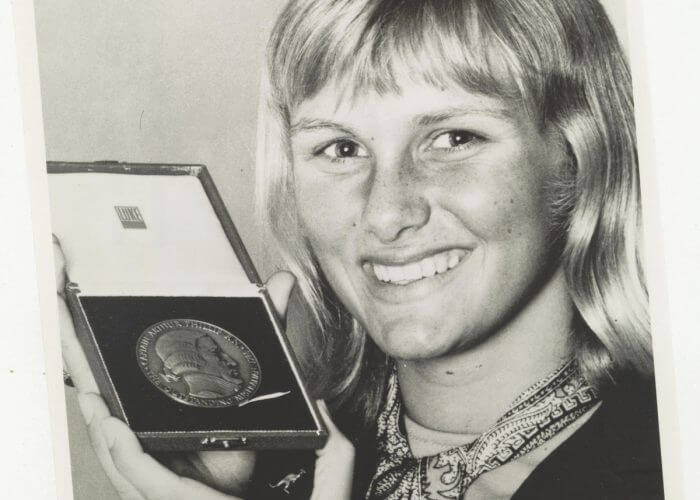
Shane Gould – a Living National Treasure in Australia – Photo Courtesy: Swimming World Archives
Gould’s own take on all things swimming is based on her research, which is in turn linked to a lifetime time of experience.
She had a bad accident when she was about 18 months old and poured boiling hot water on herself but that early experience was not what stuck. Her parents, Shirley and Ron, would take her and older sister Lyn down to the beach at Parsley Bay and Rose Bay in Sydney Harbour before the family moved to Fiji when Shane was three years old.
She would later recall:
“In my father’s words, I came alive in the water. It became water therapy and he just kept taking me there until I was independent. Then my older sister used to accompany me to the pool, and we just spent hours and hours, although we’d get in trouble if we were home after 5:00 pm.”
Gould’s view of ‘what is swimming’ has changed down the years, including this observation: “I think the idea of swimming has become a lot more regulated, not only the facilities but learn-to-swim is much more structured and has kind of gone back to its roots a bit, which were militaristic methodologies.
“For example, in Hobart there was a guy who taught swimming for the military in the ‘40s. He had a five-day program and then he adapted that for children. Many Tasmanian children learnt to swim in this militaristic style. I think they didn’t really like [the experience] much at all. A lot of fear was not really addressed and it was terribly cold water, so it was a pretty unpleasant experience.”
In the course of her research, she travelled back to Fiji on a regular basis in pursuit of understanding what swimming was. She went to one pool in Sydney just to watch what teenagers did when they “went swimming” for the day. She set a stopwatch for periods of 40 and 60 minutes and monitored specific individuals to see how long they spent in a position of between flat (swimming position) and 45 degrees (swimming at a less efficient angle).
“They spent less that 1% of their time in that [zone/angle] … the rest off the time they travelled in a more upright position, moving in chunks of 2-5 seconds at a time. They these teenagers would go home and say ‘mum, I’ve been swimming all day’ when actually they’d been swimming about 20 seconds [per the 40mins slots of measuring].”
That observation and comment is not necessarily a criticism but needs to be understood in the context of the purpose of Gould’s research.
Nelms, for example, talks of swimming lessons as having “kind of removed those feral and natural learning experiences … If your only experiences are limited to regimented and programmed lessons, I think the way to naturally adapt to the water and become less fearful is sometimes skipped over.”
He and Gould work with children, including children who have or develop a fear of water, in Sweden, as part of their enterprise with the SCAR.
Early experiences in water “create very deep memories”, says Gould.
Some of those may speak to the very environment in which swimming takes place. As a child, I, this author, hated going swimming and it was assumed I was frightened of the water. In fact, it was the cacophony of human voices in pools where the acoustic pitch was painful for my young ear. My father sought out quieter places and spaces and back in noisier places, found things to distract so that the mind could be quiet even when noise was all about. Its became a useful skill for many years after, in busy newsrooms and on the press bench at major sports events.
Gould points to another aspect of pools: “My Masters was about public space, the swimming pool as a public space and seeing how teenagers use that space with the view to looking at how swimming pools were designed and how they functioned … because they’re concrete boxes with straight lines and quite uninviting edges, many young people … teenagers in particular, will prefer to go to a natural water location rather than being in that very rigid space.”
In Lund, Shelley Whitehead, the Director of Aquatics at HALF Fish HQ in Britain, notes her association of swimming with a culture of volunteering to save and create new swimming spaces and experiences.
The HALF Fish motto is: ”Where everyone swims together”. Whitehead earned plaudits from Gould, who then noted that the word “fun” had been used several times by those providing views in the active thinking session. Says Gould:
“I noticed that a lot of advertisements for swimming schools in Australia use the word “fun” but wondered ‘what do they have to use ‘fun’ when swimming is inherently fun. Just get in the water and its an enjoyable experience. So, the philosopher says ‘what is fun?’; what do they mean by ‘fun’, what’s meant by ‘fun’?”
“To me, fun is something that’s challenging, something where I can learn, something that can bring me joy and just being in the water is joyful. It doesn’t have to be ‘fun, ha ha!’ Or fun [she lets out a high pitch giggle and streak that provokes the same back in various tones and shades from the audience] … loud noise. I encourage you to think about what you mean by fun. Children are very satisfied by learning and exploring and discovering.”
Gould provided other answers to that and many more questions in other lectures in Lund but the fascinating thing about all her presentations was the number of though-provoking questions she came up with on a subject she has more knowledge on and of than almost anyone else courtesy of the long learning curve she has travelled wilfully and with the kind of wonder and worldliness we got a tiny glimpse of in her days as a shooting star of swimming in the Olympic fast lane of pace and practice pioneers. Extend that thought to Forbes and Ursula Carlile, who will be inducted in the International Swimming Hall of Fame this year.
In Lund, Gould concluded: “I think your contributions (in the active thinking session) are an affirmation that there is a unique culture in swimming and importantly shared values and meanings of the benefits of being able to swim. These are some of the general ‘red threads’ his conference is trying to highlight and speak about. They are red threads that unite people and define the culture that awe are all a part of. Thank you very much.”
Thank you – and Happy Australia Day – Dr. Gould.
2020s Vision
In this first quarter of the new decade and 2020, we will consider the following themes:
- The Athlete Voice
- Swimming Culture – what is it?
- Gender Vs Sex: a waking nightmare for women’s sport?
The Athlete Voice:
- Matt Biondi’s Mission To Enrich & Educate Swimmers
- ‘Alliance’ Not ‘Union’ Aims To Take ISL Model To Multi-Sports ‘Games Of Magic’
- Athlete Voice Needs Coach Voice Of Experience, Reason, Objectivity, Says Rudd
Do you have a contribution to make, a topic to suggest within the frame of the themes we are looking at this quarter? Your views on any theme can be left in the comments field at the foot of any article, while those who want to reach out with suggestions to the editorial team can contact us at editorial@swimmingworld.com.



